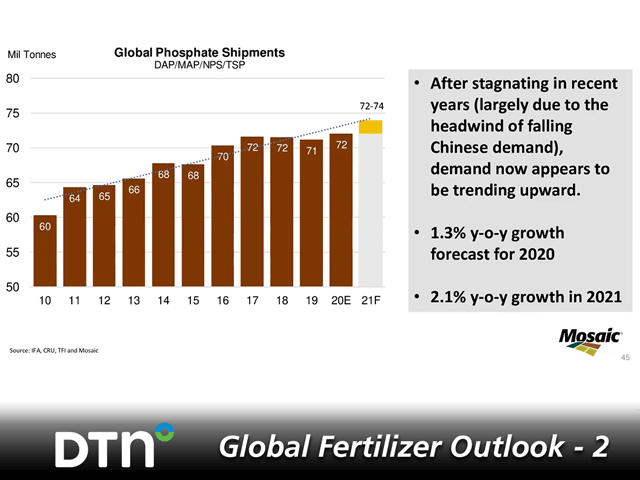Global Fertilizer Outlook - 2
World Phosphorus Market Unbalanced in 2020, Looks More Balanced in 2021
OMAHA (DTN) -- After several years of steady global phosphorus (P) demand, the world's farmers could increase P consumption in the coming years, thanks to higher crop prices. This creates a "snug" global supply-and-demand situation in 2020, although this could change in 2021, according to a fertilizer analyst.
Presentations were made on the short-term market outlook at the 2020 T3 Virtual Fertilizer Conference -- Trends, Technology and Transportation, put on by The Fertilizer Institute (TFI). This new conference replaced TFI's Fertilizer Outlook and Technology Conference as well as the North America Fertilizer Transportation Conference that usually takes place during the fall.
POSITIVE FARM ECONOMICS
Andy Jung, vice president market and strategic analysis for The Mosaic Company, presented the P market outlook. Farm economics in 2020 could be the best in six years with farmer net farm income aided by higher crop prices and government payments, he said, adding this creates more affordable fertilizer prices. The fertilizer market is quite affordable versus the historical pattern, he said.
"Total plant nutrient costs are lower year on year," Jung said. "The phosphate affordability index also remains less than the long-term average."
Jung said the tightening supply-and-demand situation in 2020 pushed global P prices higher. The P market ran a theoretical deficiency in 2020 with increasing demand and little additions to overall supply, he said.
The global net price rebounded in 2020 for a return to industry-sustaining margins. This indicator acts as almost the health of the industry, and with slightly higher prices now, this puts the industry in a more sustaining level, he said.
MORE BALANCED IN 2021
The outlook for the supply-and-demand situation in the global P market in 2021 is for more balance, according to Jung.
The projected supply shipment in 2021 is an expected increase of 2.1%. There should be some successful increases of supply next year, creating a situation in which the P market should be well balanced, he said.
Jung pointed out, however, that the market is depending on the supply side for some ramping up of new capacity, something that does not always happen.
P[L1] D[0x0] M[300x250] OOP[F] ADUNIT[] T[]
"If history is a guide, there is probably some asymmetrical risk to the downside whether or not those operations will be to successfully ramp up based on the recent past," he said.
P DEMAND GROWS
The short-term P demand outlook now shows some growth trajectory after it was stagnant in recent years, mainly due to the headwinds of falling Chinese domestic demand. It was common to see this demand fall by well over a million tons a year, he said.
However, this trend should change as P demand now appears to be trending upward, again thanks to strong grain prices.
Jung said the 2021 forecast is between 72 million to 74 million metric tons (mmt) of global phosphate shipments. Global P shipments in 2020 are estimated to be at 72 mmt while it was at 71 mmt in 2019.
A demand growth forecast for 2020 is expected to be 1.3% year on year, while the increase for 2021 could be closer to 2.1%, he said.
"We should see a good, snug P supply and demand throughout 2021," Jung said.
BRAZIL PUSH FOR P
Demand for P in select countries is pushing the nutrient's demand globally, he said.
Brazil has seen strong P demand, which has led to dramatic year-on-year import volumes, Jung said. Imports are nearly 0.5 mmt higher or about a 9% increase year to date.
This increase in Brazilian P imports is expected to moderate some into 2021. Generally, P demand growth is expected to remain into next year, he said.
At the same time, Brazilian P ending stocks have seen little increase in 2020. P ending stocks are just 6% higher year on year, he said.
INDIA P IMPORTS RISE
Much like Brazil, India has seen P imports increase in 2020. Indian P imports are 10% higher or 0.44 mmt more year on year.
Unlike Brazil, India has seen P stocks fall dramatically in 2020. P ending stocks are 52% less or 1.35 mmt less than year on year, he said.
In addition, India P domestic production is down in 2020 from the previous year. Productions is down 13% year to date or 0.45 mmt less year on year.
Jung said strong P demand has pulled India's P stocks lower, although higher import levels will offset the lower domestic production.
"We saw a surge in June-to-September imports, which was the catalyst for rising global prices," he said. "We expect strong import appetite to continue."
CHINA DEMAND
Another driver in the global P demand situation is Chinese P exports, he said. Chinese exports are the main swing factor for the global P supply-and-demand market.
China usually exports about 10 mmt of P, but year-to-date data shows exports are 13% less or about 1 mmt fewer year on year.
The recent modest annual year-over-year volume declines are expected to continue, with broadly flat production and stable to higher domestic demand, Jung said.
Russ Quinn can be reached at russ.quinn@dtn.com
Follow him on Twitter @RussQuinnDTN
(c) Copyright 2020 DTN, LLC. All rights reserved.






